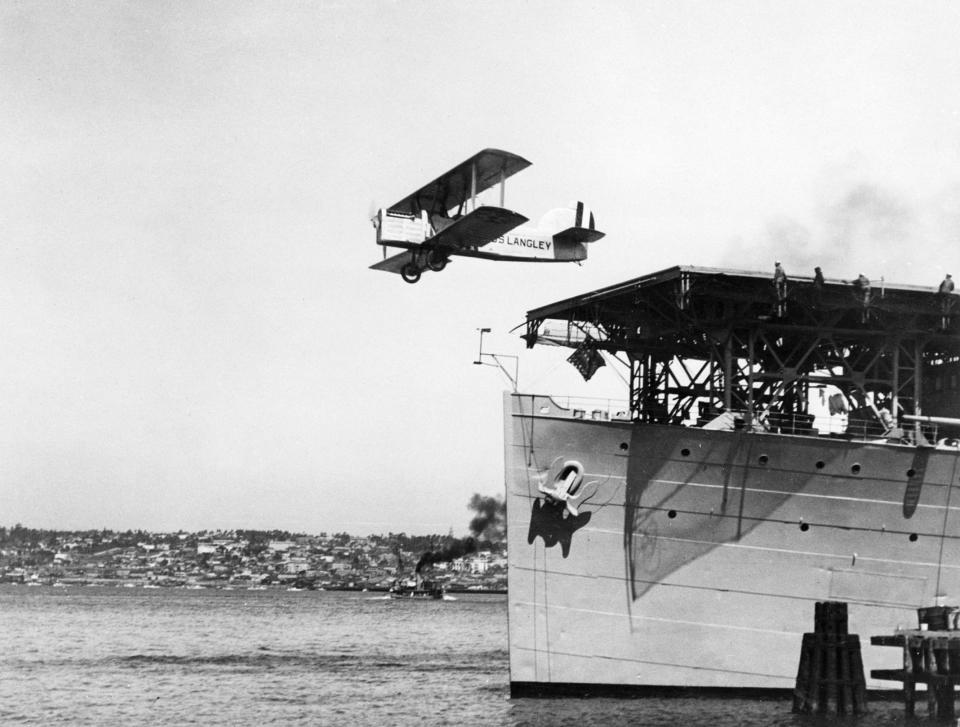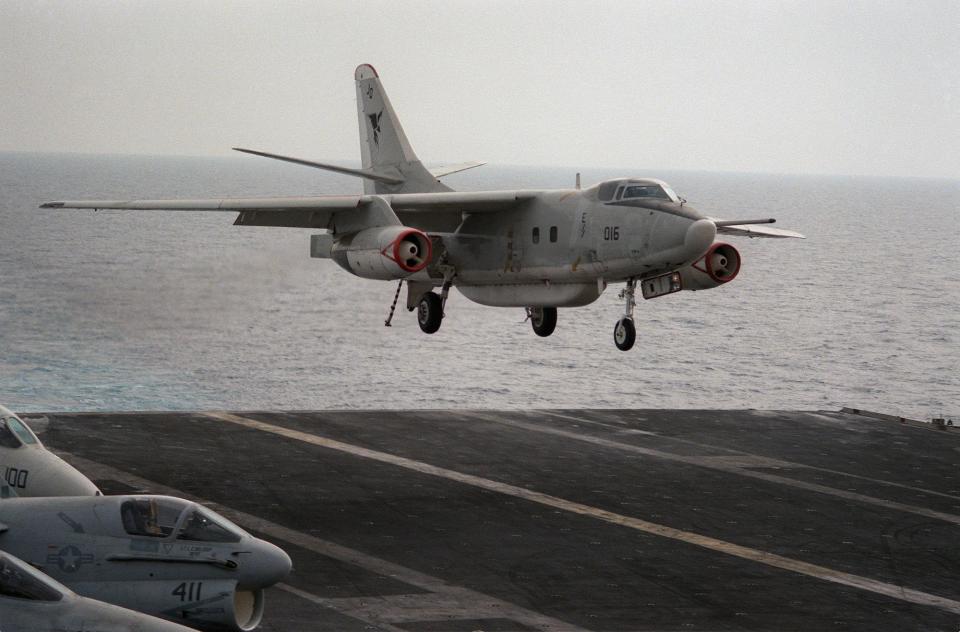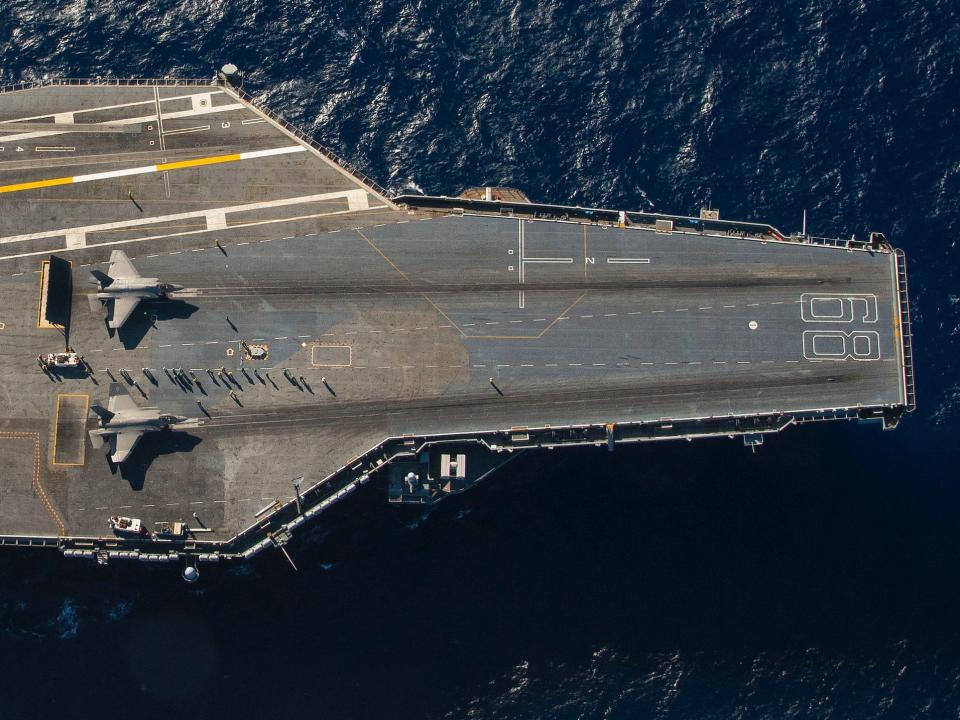From biplanes to drones: How the Navy's carrier aircraft have dominated battlefields for almost a century

Navy aircraft carriers, and the airwings they bring with them, have projected US power around the world for decades.
That airwing has evolved, and its pilots have flown some of the most advanced aircraft to see combat.
American aircraft carriers are one of the most dominant naval weapons in existence. Since their trial by fire in World War II, US carriers have played key roles in all US wars and become essential to US force projection.
Virtually all of that is due to each carrier's air wing. Despite humble beginnings, US naval aviators have flown some of the most sophisticated aircraft ever built.
Here is how carrier air wings have secured control of the seas, dominated the sky, and supported ground operations.
The first carrier aircraft

The first American plane to take off from a US aircraft carrier was the Vought VE-7 "Bluebird." The carrier, USS Langley, was a collier that had been converted into an aircraft carrier in an effort to catch up to other naval powers.
The first generation of carrier aircraft were biplanes. The VE-7 was the Navy's frontline fighter until 1928. The arrival of Lexington-class carriers in 1927 gave the Navy the ability to field dedicated carrier aircraft, including torpedo bombers. As a result, the Navy went through a whole slew of biplanes.
The prime examples were Curtiss F6C Hawk, the Martin T3M and T4M torpedo bombers, and the Grumman F3F - the last biplane in service with the US military.
The heroes of WWII

By the start of World War II, almost all US carrier aircraft were monoplane designs. Navy carrier aircraft saw little action in the inter-war period, and it was during World War II that they really proved their worth.
The most famous carrier fighters of the war were the Vought F4U Corsair and Grumman F6F Hellcat. The Douglas SBD Dauntless dive bomber, and the Grumman TBF Avenger torpedo bomber were also vital to Allied victory in the Pacific.
Easily identifiable from its distinct gull-wing design, the Corsair was adopted in 1942. Though it initially faced technical problems, Corsairs claimed over 2,000 victories with 189 losses to enemy aircraft, a ratio of over 11:1.
But the Hellcat was the Navy's best fighter. Entering service in 1943, Hellcats claimed over 5,000 kills in the Pacific to 823 losses to enemy fire. It was also a superb escort fighter, with only 42 carrier-based bombers and torpedo planes lost between 1943 and 1945.
The Dauntless and Avenger were vital against the Japanese Navy. Dauntlesses helped sink 300,000 tons of enemy shipping, including 18 warships, six of them carriers. Avengers also helped sink a large number of Japanese vessels, including 30 submarines, three carriers, and three battleships - two of which, the Yamato and Musashi, were the largest and most powerful battleships ever built.
Strategic bombers

With the end of World War II, the US Navy had few enemies with developed navies that posed serious threats. As a result, carrier aircraft shifted to supporting operations inland.
A new emphasis was placed on bombing capability, especially with nuclear weapons as the Polaris submarine-launched ballistic missile (SLBM) was not yet developed.
The Navy had three strategic bombers in service during the Cold War. The first two, the North American AJ Savage and the Douglas A-3 Skywarrior, could carry either 12,000 pounds of conventional bombs or nuclear weapons, while the A-5 Vigilante was intended solely for dropping nukes.
The Savage had a troublesome service record and eventually operated mostly from land. Some Skywarriors saw limited bombing service in Vietnam, but most were converted for surveillance and aerial-refueling duty, with some seeing service up to Operation Desert Storm.
The Mach-2 capable Vigilante had an interesting design, with its internal bomb bay accessible only through a hole between its two jet engines. But by the time it entered service, the Navy had switched to SLBMs as their primary delivery method for nuclear weapons.
As a result, the remaining A-5s were turned into reconnaissance aircraft and saw extensive service in Vietnam.
Fighter-bombers and electronic warfare

The Vietnam War was an important experience for naval aviation, as North Vietnamese surface-to-air missiles and MiG aircraft proved troublesome opponents. The Navy found itself conducting five types of missions: dogfighting, bombing, reconnaissance, electronic warfare, and aerial refueling.
The best fighter for the Navy during the war was the Vought F-8 Crusader.
Crusaders were the first US aircraft to fight North Vietnamese MiGs and eventually claimed 19 killed against just three losses in aerial combat, giving it the best kill ratio of any American aircraft in the war. (The Crusader also had a reconnaissance variant, the RF-8, which was vital during the Cuban Missile Crisis.)
The Navy's primary attack aircraft was the Grumman A-6 Intruder. Its long range and payload of 18,000 pounds, combined with its all-weather flight ability, made it the most important weapon for the Navy at the time.
Navy and Marine Intruders flew more than 35,000 sorties during the war, and it stayed in service until 1997.
The aircraft was versatile enough to be used for multiple missions, including enemy air defense suppression, aerial refueling, and electronic warfare (EW). In 1971, a dedicated EW aircraft based on the Intruder, the EA-6B Prowler was introduced and remained in service until 2009.
The F-14 Tomcat

Perhaps the most loved carrier aircraft is the Grumman F-14 Tomcat. Meant to replace the McDonnell Douglas F-4B Phantom II, the Tomcat was a twin-tail variable-sweep wing multirole fighter primarily tasked with the interceptor and air-superiority roles.
The unique wing design served more than an aesthetic purpose. During takeoff, the wings were positioned forward, expanding the surface area and providing greater lift. When it reached supersonic speeds, the wings would fold backward to be more aerodynamic, enabling it to achieve a top speed of Mach 2 - faster than today's F-22 or F-35.
The Tomcat was a US carrier's first line of defense against incoming enemy aircraft and could even track and engage cruise missiles. Ten hardpoints enabled it to carry over 14,000 pounds of ordnance, including rockets, bombs, and missiles.
Tomcats were used in a number of air interception and bombing missions during its 32 years of service.
The most eventful actions were in the Middle East and North Africa. American Tomcats shot down five enemy aircraft, including two Libyan Su-22s and two MiG-23s, during the first and second Gulf of Sidra Incidents, and one Iraqi Mil Mi-8 during the Gulf War. Only one Tomcat was ever lost to enemy fire.
The Navy's current and future workhorses

With the Cold War over, the F-14's high maintenance costs were hard to justify, especially since upkeep of the McDonnell Douglas F/A-18 Hornet was much cheaper.
The Navy decided to retire the F-14 in 2006, but rather than seen them go to Iran, one of the only other countries to operate the F-14, the US destroyed its remaining Tomcats.
The Hornet, in service since 1984, has been a versatile workhorse for the Navy, seeing combat in Libya, Iraq, and Syria. The platform has been so capable that an electronic-warfare version, the Boeing EA-18G Growler, was adopted in 2009 to replace the Prowler. An upgraded version, the Super Hornet, arrived in 1999.
The Navy plans to buy more than 250 of the F-35C, the carrier variant of the Joint Strike Fighter. The F-35 program and efforts to equip carriers to operate it have both struggled, but the Navy is moving ahead - the first two F-35C pilots graduated the Navy's TOPGUN course in summer 2020.
In the future, the Navy also plans to acquire at least 72 MQ-25 Stingray carrier-based aerial refueling drones. The Stingrays are expected to substantially increase the range of a carrier's airwing, enabling carriers to stay outside the range of sophisticated anti-ship weapons.
In a sign that the MQ-25, and other unmanned aircraft like it, are a major part of the Navy's future, the service's newest carrier, John F. Kennedy, features a Stingray on its seal, alongside mainstays like the F-35C and F/A-18.
Read the original article on Business Insider

